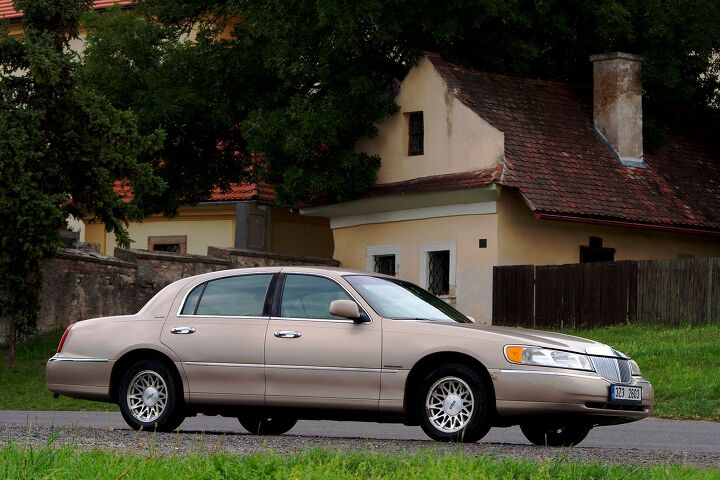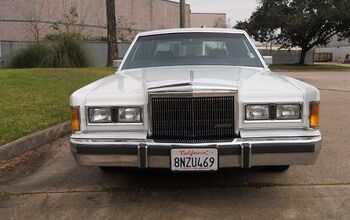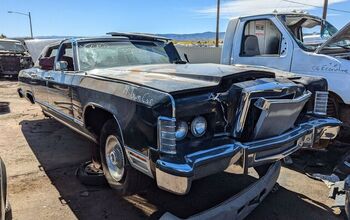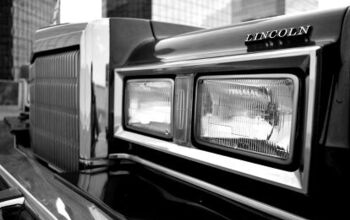Myths and Legends: Lincoln Town Car
The late model Panther cars offer a unique combination of fairly modern driving characteristics and the classic feel of RWD, body-on-frame vehicle. With their longevity and durability, cheap parts and surprisingly frugal 4.6 Modular engine, they are even quite cheap to run. Of course, that’s all true if you believe the hagiography of the Panther so earnestly propagated by this site, and other outlets. But does it have any grounding in reality?
Last fall, I had the fortune of getting my hands on nearly exactly the car I’ve wanted to try. Even better was that I didn’t just borrow it for a while for a review – I got a chance to drive it for extended period of time. In fact, I’m still driving it.
The car in question is a 1998 Lincoln Town Car Signature Series. The first year of the new, much more rounded (dubbed “Hyundai-look” in Czech US car enthusiast circles) and brutally decontented model. Electric trunklid pull-down? Fuggetaboutit. Keyless entry keypads on the doors (the feature which was always one of the reasons why I wanted to own a Lincoln)? No way. You don’t even get a storage box in the passenger door with the model year, although there are fake shut lines.
So, in some ways, this could be a prime example of “how the mighty have fallen”. Proud name, once-proud-badge and huge size, but inside, the materials, fit and finish of a cheap econobox from somewhere in South East Asia.
Now add the chassis and suspension, still based on that of the 1979 Panther, and the big V8 with a meagre 200 horsepower, which wasn’t exactly stellar performance in late 1990s. Not to mention the four speed slushbox. It seems you have every reason to declare this car an antiquated piece of junk and move on. But as you probably already guessed, my opinion is quite a bit different. Why?
Being a broke motoring journo in Europe with a taste for big V8s, is the running costs. Forget everything you have ever heard about European engines being frugal. They’re frugal because they’re small and fitted in small cars. If you compare them pound for pound and horse for horse, the outcome isn’t nearly as favorable. The Town Car is, in gentle driving, able to get 8.5 l/100km (27mpg) on European roads, and I’m sure that there’s still some room for improvement – 30mpg seems totally doable to me. And even when you don’t do an economy run, it still moves at 9 – 9.5 l/100km pretty comfortably.
A similar-era Mercedes 220CE (famous W124) got pretty much the same fuel mileage as the Lincoln – even in city traffic. And although the V8 power doesn’t help the Lincoln to be any quicker than the four-cylinder Benz, the whole notion that you can drive a big, smooth V8 and use as much gas as the rough four-cylinder gives one pause.
And then there are the spares. For many people, the fear that spare parts for an American car will be hard to get in Europe is one of the main reasons not to buy one. They’re also right in one respect – if you need your car to be ready at all times, and spares to be available within 24 hours, you have to look elsewhere. That little pond between us still doesn’t help with quick delivery, and you will wait for your parts for about a week (specialised US car part vendors here in CZ), a few days (RockAuto, quick but terribly expensive shipping) or up to two months (container transport, extremely cheap). Compared to the fact that most parts for common European models can be had within the aforementioned 24 hours, it is a major downside of owning an American car here. But the upside is that the parts are really cheap.
Remember that those fragile European cars with expensive spares are the norm here – and parts aren’t any cheaper for them in Europe. In fact, when you include taxes, even spares for European cars are sometimes cheaper when you get them from US. Things like getting a whole set of shocks for $50 in US, which means some $100-120 with postage, custom duty and tax? People don’t believe me when I tell them how much I paid. They usually think that spares for US cars have to be outrageously expensive when they’re shipped overseas (like other spares weren’t shipped from China) and they’re flabbergasted when they find out that stuff for the Town Cars costs half that of the parts for the locally produced Škoda Octavia of similar vintage.
So, is it all about the Town Car being a huge car that is affordable to drive? A way for someone who’s broke to brag about his car being bigger than the S-class Mercedes? It’s not even that big on the inside – except for the sheer width, the short version of the Town Car is not that much more spacious inside than a Ford Mondeo. So, is it just the “mine is bigger than yours” thing?
I may be lying to myself, but I don’t think so. No, for me, the real reason to drive a Town Car is the way it drives, the way it feels on the road and how it feels inside. Some of you may remember my older article about the Chevy Caprice and the magic of RWD, body-on-frame sedans/wagons. I loved the GM B-bodies and old Panthers because of their unique way they drive – the combination of soft-sprung suspension, huge torque on tap, super-light steering wheel and lots of lock, making it more akin to steering a motorboat than driving a car.
The last generation Panthers promise to preserve the old-timey driving characteristics, and add much better roadholding, higher mileage and modern comforts. But the thing I always wondered about was whether the suspension and steering improvements didn’t spoil the unique character of the old BOF sedans.
And after several months of using it daily, I can say that both my hopes and fears were fulfilled, in some ways.
The first good thing is that with all the suspension improvements, like sway bars front and rear, Watts link and stiffers springs and shocks, the modern Panther is stable enough at any normal speeds. I have never tried to go really fast with it, but I’m sure it can stay planted at 100mph on highway.
Another good thing is that it has kept lots of the old Panther’s character. It’s still a big boat, with that unique feel coming from the combination of driver’s position being near the middle of the car, long overhangs, great lock and so on. Add the light, numb steering and sofa seats, and you still have a car that makes you want to go slowly and gently – which is perfect for when you want to get to your destination relaxed and with great mileage, as opposed to being stressed from high-speed run provoked by the sporty suspension of some modern European car.
The bad thing? Chasing the handling improvements, Ford engineers decided to fit much sitffer springs to the front of the Town Car. The outcome is the loss of much of the typical “floatiness”, without gaining significant high-speed handling imrpovements that weren’t already there thanks to the sway bars and Watts link. I even looked at replacing the springs with softer ones from the older model.
Another bad thing is the engine’s need for revs – it’s not as effortless as the old 302 was. On the other hand, the fuel economy is more than enough to make up for that.
But overall, those are small things. The main point of owning a Panther is that it still offers more than just a whiff of the “classic American feel”, while being totally useable and reasonable as a daily driver. The fact is that if you’re used to driving an 80s Panther – or even its prefecessors from 1970s or even 1960s, you will still feel right at home in this car. As Murilee once put it, when describing his old 1990s CrownVic Police Interceptor – this car is what the 1960s fullsize sedans should have been.
Myth or Legend?
Do I need to drive it?
Should I buy it?
@VojtaDobes is motoring journalist from Czech Republic, who previously worked for local editions of Autocar and TopGear magazines. Today, he runs his own website, www.Autickar.cz and serves as editor-in-chief at www.USmotors.cz. After a failed adventure with importing classic American cars to Europe, he is utterly broke, so he drives a borrowed Lincoln Town Car. His previous cars included a 1988 Caprice in NYC Taxi livery, a hot-rodded Opel Diplomat, two Dodge Coronets, a Simca, a Fiat 600 and Austin Maestro. He has never owned a diesel, manual wagon.
More by Vojta Dobe
Latest Car Reviews
Read moreLatest Product Reviews
Read moreRecent Comments
- Calrson Fan Jeff - Agree with what you said. I think currently an EV pick-up could work in a commercial/fleet application. As someone on this site stated, w/current tech. battery vehicles just do not scale well. EBFlex - No one wanted to hate the Cyber Truck more than me but I can't ignore all the new technology and innovative thinking that went into it. There is a lot I like about it. GM, Ford & Ram should incorporate some it's design cues into their ICE trucks.
- Michael S6 Very confusing if the move is permanent or temporary.
- Jrhurren Worked in Detroit 18 years, live 20 minutes away. Ren Cen is a gem, but a very terrible design inside. I’m surprised GM stuck it out as long as they did there.
- Carson D I thought that this was going to be a comparison of BFGoodrich's different truck tires.
- Tassos Jong-iL North Korea is saving pokemon cards and amibos to buy GM in 10 years, we hope.

















































Comments
Join the conversation
Gotta say if I'm TC shopping, I'd first look for a 95-97 (pref 96) in Cartier or special edition (Cypress, Spinnaker, Diamond), followed by the 03+ with the clean styling, preferably in Platinum L or whatever that higher trim was. I've never been a fan of the pinky-taupe color you chose. Any particular reason for that, and for a Sig rather than a Cartier?
i have a 1997 Towncar that I drive every day, as well as a 1970 Thunderbird and a 2011 Mustang. Is the Towncar fast? NO! its not supposed to be. Let me try to explain this so the yuppies on here can understand. The Towncar is one of the last types of cars that was built to be one thing, for example Comfortable and quiet. Sum that up as Luxurious if you want. New cars today try to be all things to all people, and when you take one thing, on a budget, and try to make it 15,000 different things you know what you get? Garbage. Nothing ever works. New cars have to be "sporty" (which most sedans are not, sorry silly Camry drivers even in sport mode you are pathetic) and have a good ride. It doesn't happen. You get this flim flam kinda good ride kinda not that is terrible. The Towncar showed up and said, "hey, I am comfortable not sporty. throw me around some corners and ill remind you of that" My towncar rides great, its very comfortable, and the stock JBL sound system sounds great. I have put on tires and replaced the badly designed plastic manifold ($200 one time thing). I found it on C-list from an elderly couple that babied it, and they were so excited I was not going to put those stupid 22'' rims on it. I purchased it for $3000 with 59K on the odometer. One of the best bang for the buck deals ever. By the way, I am 21, my friends call me grandpa until they get in it. After a few miles they love it. :)